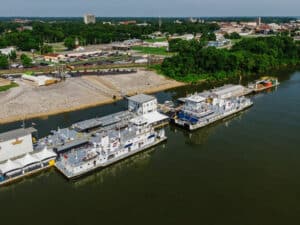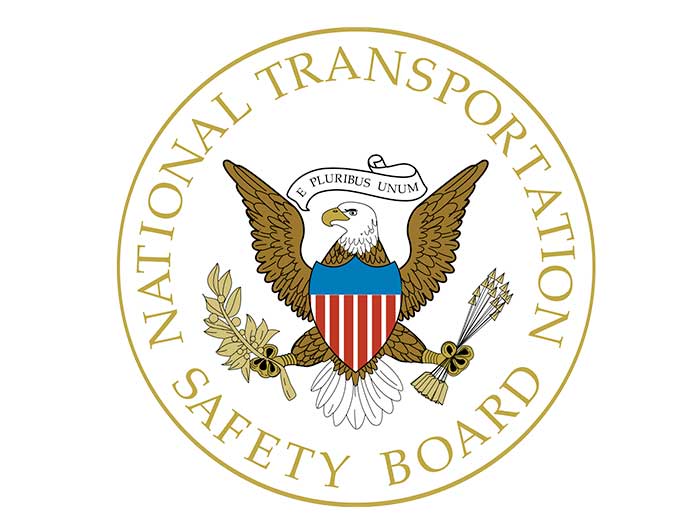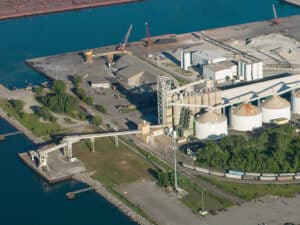
NTSB reports on expensive barge strike on bridge fendering
Written by Nick Blenkey
Image: NTSB
The National Transportation Safety Board has published its report on an August 19, 2020, incident in which a loaded Brance Diversified Inc. hopper barge, pushed by a River Ventures LLC towing vessel, struck the protective fendering of the Peter P. Cobb Memorial Bridge, near Fort Pierce, Fla.
There were no injuries to the four crewmembers on the towing vessel and no pollution reported. Damage to the barge was estimated at $5,000. Damage to the protective fendering of the bridge was $641,000.
According to the NTSB report, the 1972-built, 51-foot towing vessel Old Glory departed Hillsboro Beach, Fla., at Mile 1,052 of the ICW, at 1900 on August 17, 2020, pushing the 230-foot-long, 45-foot-wide barge Cole with about 1,600 tons of dredge material northbound for Jacksonville, Florida. The length overall of the tow was 281 feet with a maximum beam of 45 feet. The deepest draft of the tow was the barge Cole at about 7 feet.
“About midnight on August 19,” says the NTSB report, “the relief captain took over the watch from the captain at mile 982 of the ICW. Nothing was out of the ordinary when the relief captain took the watch. The relief captain checked the tides and currents using the electronic chart system (ECS) and saw that low tide for St. Lucie Inlet (about 22 miles south of the accident site) was at 0230.
“At 0245, the Old Glory was about a half mile south of the Peter P. Cobb Memorial Bridge. In preparation ffor the northbound approach to the bridge in darkness, the relief captain called the on-watch deckhand up to the wheelhouse as a lookout. The automatic identification system (AIS) track history of the vessel recorded that the ground speed of the Old Glory was 5.5 mph with a course over ground of 337°. According to the relief captain, the current started to set the vessel and tow from the center to the west side of the channel. About 0246, the course over ground of the tow was now 333°, and the bow of the barge was outside the western limit of the channel.
“At 0248, about a quarter mile from the bridge, the ground speed of the Old Glory was 5.9 mph with a course over ground of 331 degrees. Both the Old Glory and the Cole were now outside the western limit of the channel by about 65 feet, in an area with depths of 7.6–8.6 feet (based on the tidal conditions at that time), according to the most recent survey (October 2009).
“The relief captain explained that the current took the head of the tow to the west (port), which he was not expecting; he applied rudder correction to starboard. At 0249, the tow had returned to the westernmounted on top of the wheelhouse, the relief captain and deckhand identified the fendering as they approached the bridge. The relief captain observed the current again set the tow to the west just before the vessel reached the bridge. As he approached the bridge, the relief captain said he began to slow the tow, noting that he preferred not to travel fast under bridges.
“The tow, still at the western limit of the ICW channel, crossed into the northern approach to the Fort Pierce City Marina channel (a marked channel perpendicular to the ICW with its entrance immediately south of the Peter P. Cobb Memorial Bridge), which was maintained to a depth of 6.5 feet. The relief captain explained that “the boat started bogging down,” and he could “not bring the head back up.” He tried to “twist” the stern of the Old Glory to get the “head [of the tow] in there, as it is, to go through the bridge.”
At 0250, at a speed of 5.9 mph, the course over ground changed to 358 degrees, and the head of the tow neared the southern end of the west protective fendering. The last time the relief captain checked the vessel’s speed, it was 4 mph. He noted that he was “backing down,” but was not getting the power that he expected, which he said led him to believe the vessel was either caught on a sand bar and/or the wheel (propeller) wash was going against the barge.
“Recognizing that the alignment was poor, the relief captain, believing the tow could not safely pass beneath the bridge, steered the head of the tow into the bridge’s east fendering, which he considered the safest place for the barge to strike since it did not affect any of the bridge structures. At 0251, the port side of the barge touched up against the west-side fendering, and its starboard bow struck the eastern fender wall in the middle, damaging a 55-foot section under the bridge. The starboard-side face wire (wire that connects to a barge from the towboat’s bow to keep the barge securely against the vessel) also parted during the contact.
“Before the barge struck the fendering, the relief captain rang the general alarm to wake the two sleeping crewmembers. The Old Glory and Cole tow became wedged under the Peter P. Cobb Memorial Bridge between the east and west fendering. The vessel remained under the bridge while the accident was reported to the U.S. Coast Guard and the vessel owner, and the crew replaced the starboard face wire.
According to the relief captain, “when the tide finally changed,” the Old Glory and Cole tow “straightened itself out” under the bridge and floated out to the south with the rising tidal flow. The Coast Guard granted the tow permission to continue its transit to Jacksonville, and, according to the AIS recorded track, the tow was under way and passed through the bridge at 0635.
ANALYSIS
In its analysis, among other things, the NTSB report says:
“The relief captain checked the ECS to ascertain the tidal conditions and current at the time of the bridge transit. He said he was caught off guard, not expecting the current to be running, considering the time he was passing through the bridge was near low tide (which he understood to be 0230, rather than the nearest location to the accident that had a prediction of 0340). Both the United States Coast Pilot and navigational charts had information on ‘strong cross’ and ‘extremely fast’ currents in the area of the Peter P. Cobb Memorial Bridge.
“Although the relief captain acknowledged the available navigational information on the vessel’s ECS and in the United States Coast Pilot publication, he did not use all the resources available to him. Towing vessel regulations require the officer of a navigational watch to conduct a navigational assessment, using all resources available to gather information on conditions that could impact the safety of navigation, such as the velocity and direction of currents, bridge transit clearances, and any other special conditions. Had the relief captain been aware of the cautionary note and information contained in the United States Coast Pilot, he would have been better prepared to address the risk of strong currents often seen near the Peter P. Cobb Memorial Bridge.”
PROBABLE CAUSE
The National Transportation Safety Board determines that the probable cause of the contact of the towing vessel Old Glory and barge Cole with the Peter P. Cobb Memorial Bridge protective fendering was an inadequate navigational assessment that did not identify the risk of strong cross-currents in the area of the bridge transit.

![Tom Frazier aground and listing to starboard on Feb. 11, 2024. [Photo: U.S. Coast Guard]](https://www.marinelog.com/wp-content/uploads/2025/06/Towboataground-300x225.jpg)


